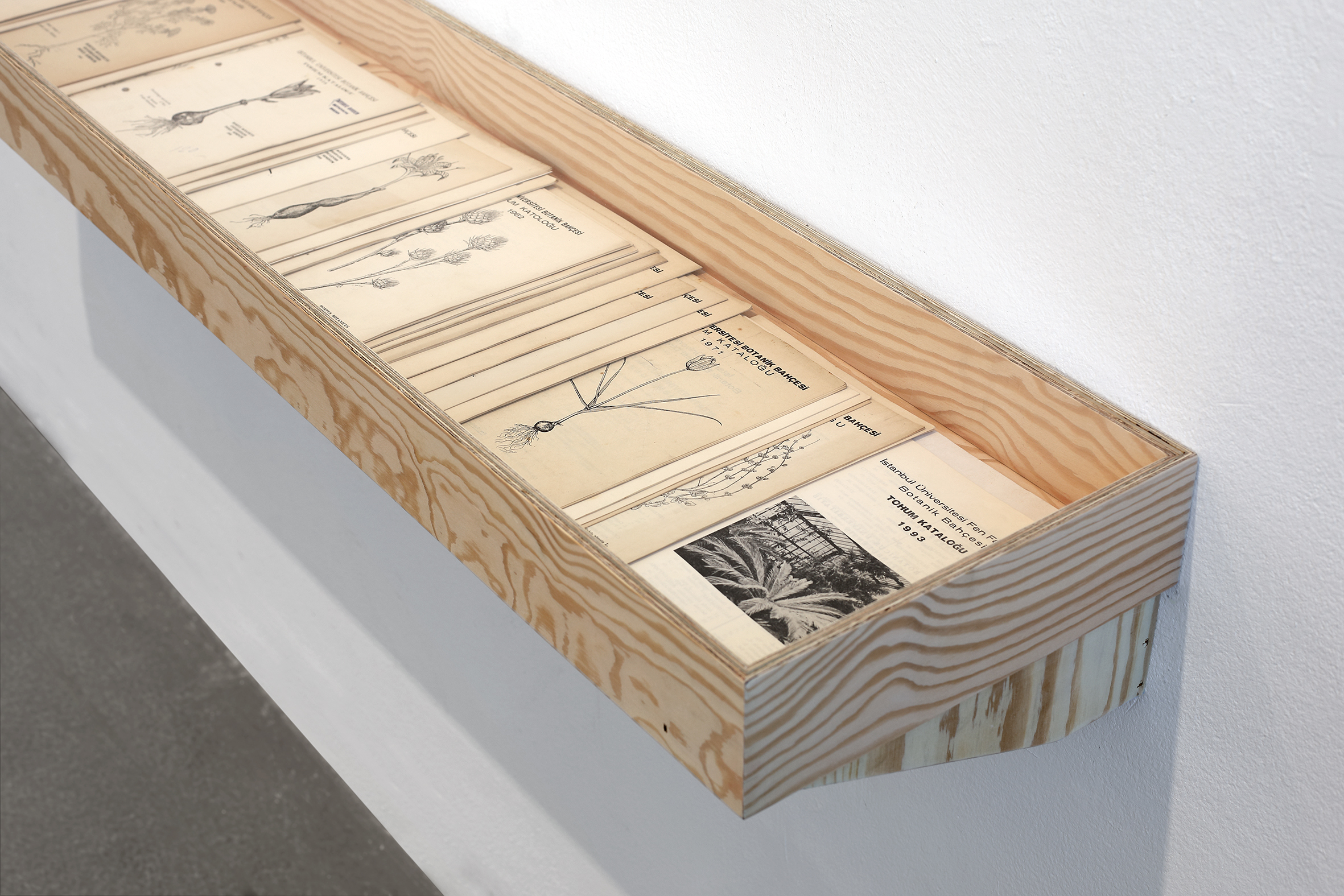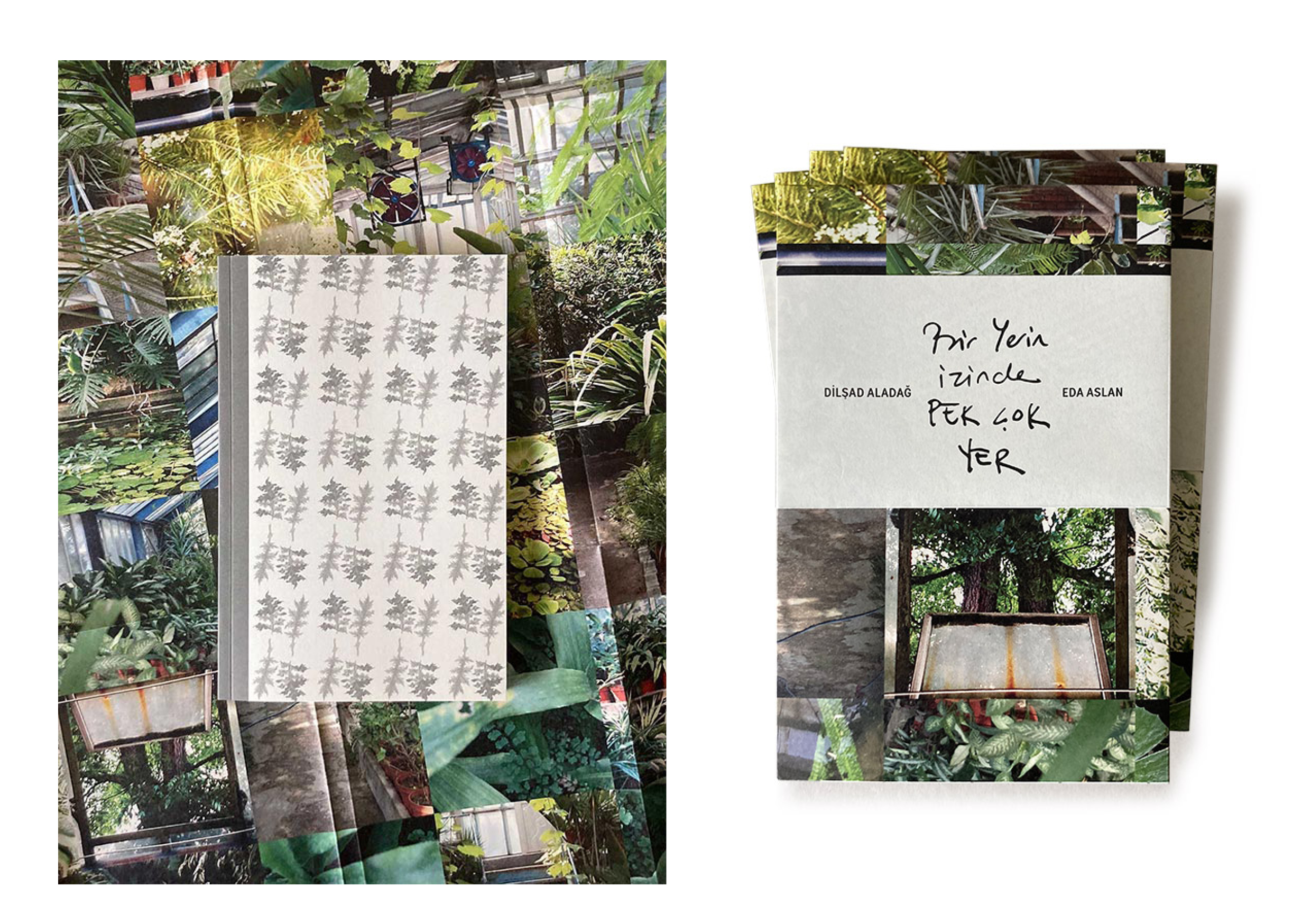The Garden of (not) Forgetting
Artistic research / İstanbul, Frankfurt, Münster / Depo İstanbul / with Eda Aslan
Unutma Bahçesi; The Garden of (not) Forgetting focus on the destructive nature of forced movements and transformations and the traces of memory left by them. The project asks in the face of possible move and destruction of the only Botanical Garden of Istanbul University due to authorities decision: “Is it possible to record a place, to keep its memory alive, to make space for the garden in urban memory?”. The project, which was initially centred around the Istanbul University Institute of Botanics, Alfred Heilbronn Botanical Garden and the plant life established here; gained new layers as it extended its focus to the archives, and the stories of the garden’s Jewish German founders s who were in exile in Turkey during WWII.
Last Year’s Herbarium
Last year’s herbarium presents the plants collected during the last year that the Heilbronn Botanical Garden was still open to the public. Without the taxonomy and classification, one can see anonymous pieces from the integrity of the Botanical Garden that are about to be forgotten.
Installation. Specially produced wooden archive cabinet with light, 415 piecess, 5x5 cm, diapositive film frames, plant samples 45x130x100 cm. Photo: C.B. Gökçeer
Last year’s herbarium presents the plants collected during the last year that the Heilbronn Botanical Garden was still open to the public. Without the taxonomy and classification, one can see anonymous pieces from the integrity of the Botanical Garden that are about to be forgotten.
Installation. Specially produced wooden archive cabinet with light, 415 piecess, 5x5 cm, diapositive film frames, plant samples 45x130x100 cm. Photo: C.B. Gökçeer
Last Year’s Catalogue
An annual catalog of botanical gardens serves to be part of the transnational scientific dialogue. By listing the plant species in the collection, a catalog invites overlap and initiates interactions between different institutions. In addition to the rejections of our attempts to access the herbarium, our request for access to the Botanical Garden’s current catalog was also rejected. This motivated us to create a Botanical Garden catalog that traces the herbarium over the past year. It too presents the garden through non-hierarchical, anonymous sheets. Each audience can have a piece of the catalog without binding, tracing the intricate life of the Botanical Garden’s plant species.
Installation, 1000 piece, 29,7 cm x 42 cm prints. 40x55x70 cm pedestal. Photo: C.B. Gökçeer
Mehpare’s Herbarium
The cellars in two countries: Turkey and Germany. Twenty boxes filled with plants preserved plants from the Ida Mountains in the 1940s by Mehpare Heilbronn. Like the scientist who was forgotten in the diaspora, the parts of the herbarium hung in limbo until they became part of the exhibition.
The cellars in two countries: Turkey and Germany. Twenty boxes filled with plants preserved plants from the Ida Mountains in the 1940s by Mehpare Heilbronn. Like the scientist who was forgotten in the diaspora, the parts of the herbarium hung in limbo until they became part of the exhibition.
The story of the plants gathered in Mehpare’s herbarium has its roots in the Ida Mountains in Turkey. The preserved plants accompanied Mehpare Heilbronn’s migration to Germany in 1959, and years after her death, eighteen boxes of herbarium files were returned to the Istanbul Botanical Garden’s herbarium by her son in 2010. The two boxes had been forgotten in a basement in Frankfurt.
Mehpare’s Herbarium presents the two boxes that were carried from the cellar in Frankfurt to the exhibition space to be presented to the public, while the eighteen boxes were trapped in a cellar in Istanbul.
Multimedia installation. 200 cm x 120 cm x 5 cm white MDF table, 40 cm x 55 cm x 17 cm timber cargo boxes, 49 files of herbarium samples. The performance of the herbarium files are on screen on a hours loop. Photo: C. B. Gökçeer
The Pool
Installation. 150 cm x 140 cm x 60 cm concrete pool, water, plant: Duckweed: Lemna minör. Photo: C. B. Gökçeer
A replica of part of the seven-eyed pool stands in the gallery as an archaic piece with its own flora. The Pool bears traces of the Institute’s modernist architecture, and the water infrastructures keep gardens alive, from ancient to contemporary examples. Lemna minor, the plant that originated in the original garden, grows in The Pool.
Installation. 150 cm x 140 cm x 60 cm concrete pool, water, plant: Duckweed: Lemna minör. Photo: C. B. Gökçeer

Seeds From the Earth
An annual catalog of botanical gardens serves to be part of the transnational scientific dialogue. By listing the plant species in the collections, a catalog invites overlap and initiates interactions between different institutions. The series of catalogs has been preserved by a generous archivist and botanist.
Installation. Original seed catalogues of Alfred Heilbronn Botanical Garden published between 1935-1993, 41 catalogues. 40x20x150 cm wooden shelf. Photo: C. B. Gökçeer
An annual catalog of botanical gardens serves to be part of the transnational scientific dialogue. By listing the plant species in the collections, a catalog invites overlap and initiates interactions between different institutions. The series of catalogs has been preserved by a generous archivist and botanist.
Seeds from the Earth follows the existences and absences of the catalogs of the Alfred Heilbronn Botanical Garden. Together with the seed collection and the beautiful drawings from the institute, it is possible to follow the absences of the catalogs of certain years, which indicate an interruption of the operation due to social and political situations.
Installation. Original seed catalogues of Alfred Heilbronn Botanical Garden published between 1935-1993, 41 catalogues. 40x20x150 cm wooden shelf. Photo: C. B. Gökçeer
Whispers Garden
Whispers Garden commemorates the struggle and determination of German-Jewish scientists who pursued their work in exile in Istanbul due to the Nazi party regime in Germany. The sound installation repeats the first letter written by botanists in German, Turkish, English and French, asking for the support of international gardens for the establishment of a botanical garden in Istanbul in 1935. The sounds of the different languages overlap and blend in the space. One can only hear the appeal if one listens carefully, attentively.
Whispers Garden commemorates the struggle and determination of German-Jewish scientists who pursued their work in exile in Istanbul due to the Nazi party regime in Germany. The sound installation repeats the first letter written by botanists in German, Turkish, English and French, asking for the support of international gardens for the establishment of a botanical garden in Istanbul in 1935. The sounds of the different languages overlap and blend in the space. One can only hear the appeal if one listens carefully, attentively.
Sound Installation. 1.06 min. in loop. Speakers, the letter read in English, French, German and Turkish languages. Photo: C. B. Gökçeer
Remembering Exercises
Remembering Exercises focuses on the forgotten archive of Alfred and Mehpare Heilbronn. The collection of the two botanists contains various documents that reflect details from the social and political environment of Turkey in the 19th and 20th centuries. The collection also reflects the history of the twentieth century. Their mutual immigration history touches on a critical historical rupture between two different geographies.
Remembering Exercises focuses on the forgotten archive of Alfred and Mehpare Heilbronn. The collection of the two botanists contains various documents that reflect details from the social and political environment of Turkey in the 19th and 20th centuries. The collection also reflects the history of the twentieth century. Their mutual immigration history touches on a critical historical rupture between two different geographies.
Video installation. 1 channel, 22’26’’. Narrator: Kurt Heilbronn. Colour correction: Sertaç Toksöz, Sound mix : Yalın Özgencil, Music: Canberk Sadullahoğlu.

Many Places on the Trail of a Place
Many Places on the Trail of a Place has been developed to revisit the places Dilşad Aladağ and Eda Aslan encountered and to memorialise and share the stories of the people they met while conducting the research for The Garden of (Not) Forgetting project.
Printed book. 15x23 cm, 143 pages, 500 copy. Launched and exhibited at The Garden of (not) Forgetting Exhibition.

Memory of a Pace Topography of a Destruction
From the stories told in this narrative, it is possible to speak of a commonality shared among structures rooted into the land, plants, stones, and people. This commonality is the state of displacement/heimatlos that changes with each period are changing ideologies. Just like the exile of the professors that are at the centre of this story, maybe this piece of land itself can be read as one of many exiles.
From the stories told in this narrative, it is possible to speak of a commonality shared among structures rooted into the land, plants, stones, and people. This commonality is the state of displacement/heimatlos that changes with each period are changing ideologies. Just like the exile of the professors that are at the centre of this story, maybe this piece of land itself can be read as one of many exiles.
The Garden of Forgetting, Memory of a Place and the Topography of Destruction research questions the connections of the present decision with conflicts and exiles from the past.
Lecture performance. 25 / 50 minute research presentation through various founded archival materials, performed in various occasions.
A Rootles Garden: Seeds, tubers and Bulbs
Installation, 2022, selection of seeds transported from Alfred Heilbronn Botanical Garden, specially produced wooden plant pots on the metal pedastalls in the dimensions of 40x30x60cm, 180x30x40 cm, 60x40x30 cm.
A Place: Garden
Video installation and mixed media, 2022, overhead projector and 5 channels, in variable length.
Video installation and mixed media, 2022, overhead projector and 5 channels, in variable length.
Color correction: Sertaç Toksöz,
Sound mix : Yalın Özgencil,
Music: Canberk Sadullahoğlu.
Places and Inhabitants